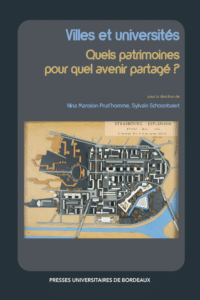UN@ est une plateforme d'édition de livres numériques pour les presses universitaires de Nouvelle-Aquitaine
Catégorie : Histoire de l’art
par Émilie Cayre
Depuis quelques années, la question du vécu de l’espace et des déplacements au sein des villes a pris une importance nouvelle faisant émerger la nécessité d’étudier et de comprendre comment l’architecture, l’urbanisme et le rituel religieux interagissaient pour construire une expérience sacrée.
Depuis 1990, les recherches sur les colorants du patrimoine historique ont considérablement enrichi nos connaissances sur les palettes et les techniques chromatiques des sociétés anciennes.
Appearance is an optical phenomenon seen by a user or captured by a sensor after the interaction of light with an object.
Current method of surveying and recording architectural heritage is mainly based on 3D laser scanning and colour photography, that is, recording what humans can see with
their naked eye.
Vestiges de tombeaux souvent anonymes et fréquemment perdus ou disparus, les gisants qui se caractérisent par la représentation sculptée d’un personnage défunt sur le couvercle de sa tombe.
Le nom de l’architecte victorien William Burges (1827-1881) n’est plus connu aujourd’hui. Et pourtant ce fut un artiste célèbre en son temps et l’ami de peintres tels que Dante Gabriel Rossetti, Edward Burne-Jones, William Morris, James McNeill Whistler et d’écrivains comme Oscar Wilde.
L’intérêt croissant porté par les programmes de recherche en sciences humaines et sociales à la 3D démontre qu’elle est devenue une solution essentielle pour faire avancer la connaissance.
par Robert Vergnieux
Les scènes égyptiennes sont identifiables par leur style figuratif si particulier ainsi que par la qualité de leur polychromie. Les décors des temples et des tombes sont principalement gravés dans des parois en pierre.
par Markus Schlicht
Une sculpture polychrome privée de son revêtement coloré est une sculpture mutilée. N’existe alors plus que le support tridimensionnel, la pierre façonnée par le sculpteur en vue de recevoir un épiderme multicolore.
When one approaches the subject of 18th century colours, the common thought is immediately oriented towards pastel or even dull colours. Tapestries from this period are no exception to the rule.
Aborder l’actualité du devenir des campus et des universités au regard de leur histoire et de leur patrimoine a paru de bon augure, à l’heure où la plupart d’entre elles subissent des réorganisations profondes
par Loïc Vadelorge
L’histoire des établissements d’enseignement supérieur a été longtemps circonscrite à l’analyse des spécificités du modèle français (grandes écoles versus universités, prépondérance de l’État sur les contextes locaux, poids du secteur public dans l’ESR, etc.) et à l’éclairage de la « longue marche » de la démocratisation puis de la libéralisation des universités.




